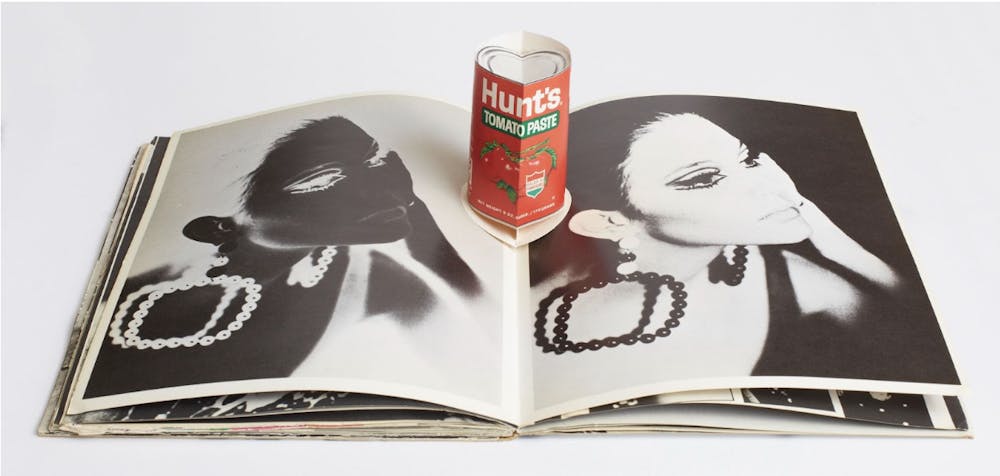“From the Archives” is an opportunity for various writers to visit the Middlebury Special Collections and write about a different artifact each week. The Special Collections boasts hundreds of thousands of historic items, and through this column we encourage writers to explore not only the college’s history, but also the history of the world around us.
Though most are familiar with Andy Warhol’s infamous Campbell Soup painting, few have heard of his 1967 popup book called “Andy Warhol’s Index,” which Middlebury Special Collections acquired in 2016. Published by Random House, the genre of this popup book is hard to define, integrating photography, written interviews, stickers, records on springs, balloons and more. Sometimes described as the ultimate hipster’s coffee table book, Warhol’s “Index” offers a view into the alternative pop culture of the late 60s.
Wrapped in aluminum foil — a favorite medium of Warhol’s — the cover depicts a sunglasses-clad man, contrasted against a print of Warhol's famous “Brillo Box.” A worn yellow sticker denotes the book’s price as a mere $4.95, shocking in comparison to the thousands of dollars these books can sell for today. The book begins with an interview between a “German Reporter” and Warhol at his disco club — The Balloon Farm — located in Greenwich Village, N.Y. The reporter wastes no time with frivolous questions; right off the bat, he asks Warhol about how he reconciles the various aspects of his career — artist, filmmaker, club owner — and how he wants to define himself and his work. The reporter receives clipped answers from Warhol, who was notorious for detesting interviews. The reporter eventually acknowledges Warhol’s lack of enthusiasm, asking, “You don't want to talk at all…” and Warhol responds “eh, no.” The interview ends there, with the assurance that it is to be continued later in the book.
The following few pages are an amalgamation of high contrast black and white photos of Warhol and his friends, a colorized pop-up of a castle, an allegedly “playable” paper record and other fun knick-knacks that illustrate Warhol’s inventive artistry. On one page, a small sheet of transparent paper is taped over a photograph of a sunbather. Instructions say “FOR A BIG SURPRISE!!! Tear out and place in a container of warm water,” a mystery that may never be revealed due to the rarity of these pop-up books today.
The second page of text that Warhol includes is an interview with Ingrid Superstar. Dubbed “Superstar” after the name of Warhol’s New York City clique of friends, Superstar appeared in many of Warhol’s underground films. This interview takes place in Warhol’s workshop, known as “The Factory,” which Superstar describes vividly. Through her candid descriptions, the reader learns that Warhol’s workshop was painted silver wall-to-wall and had aluminum foil hanging from the ceilings. Characterizing the studio as a dilapidated mess, Superstar also mentions silkscreens strewn about and faulty plumbing.
The second half of the book is dedicated to Warhol’s film and music ventures, first featuring another interview with Superstar where she discusses The Velvet Underground — an influential rock band managed by Warhol himself. In 1967, Warhol introduced the band members to the German model, Nico, who became crucial to the band as well as one of Warhol’s superstars. In fact, this book acts, in part, as an homage to the band, including many pictures and memorabilia from their early days. During this interview, Superstar discusses how intense The Velvet Underground’s music is and how they experiment with sound in a very avant-garde way, so much so that their music is not always pleasurable. Superstar also discusses what it’s like to act in Warhol’s underground movies, describing how he employs a unique split-screen tactic (where two movies are playing at once) and looks to express his artistic desires rather than to create an enjoyable film for the audience.
“Andy Warhol's Index” concludes with a return to the Balloon Farm interview. In this continuation of the interview, the reporter again asks about how Warhol defines himself and what fame means to him. Warhol responds that fame means nothing to him. The reporter, disgruntled, questions whether all of our knowledge of Warhol has been completely formed without his input, to which he responds, yes. And yet, it is in fact through this pop-up book that Warhol offers his input on public perception of him. Through these carefully curated photographs and interviews, Warhol announces to the world how he wants to be defined.
Tulip Larson ‘25 (she/her) is an Arts & Culture Editor.
She also serves as an Arts & Culture writer, mainly writing for the "From the Archives" column that highlights an item from Middlebury's Special Collections each week. In her spare time, Tulip enjoys playing music in her on-campus band and exploring Vermont.
Tulip is an English major and and Art History minor.




